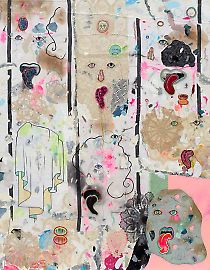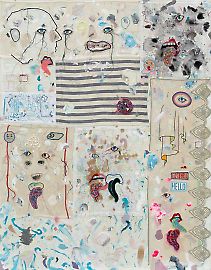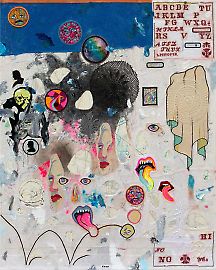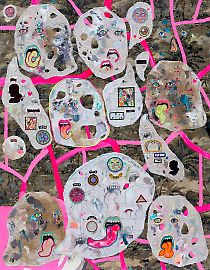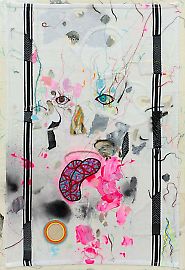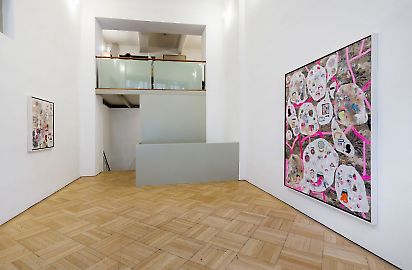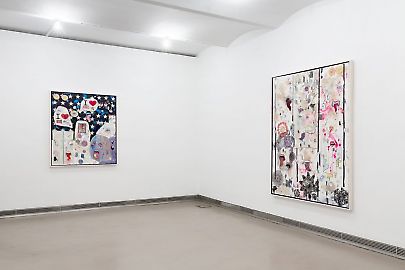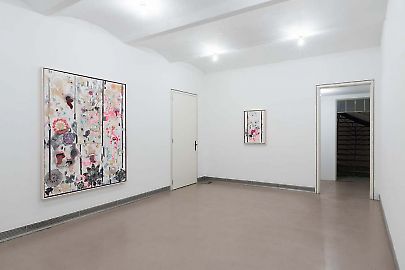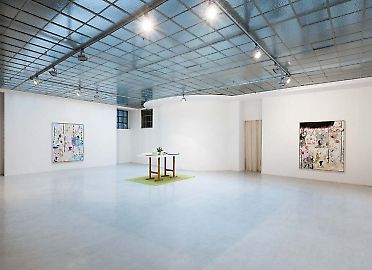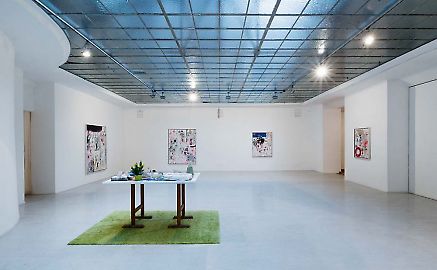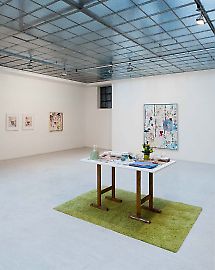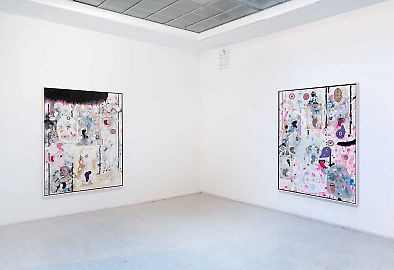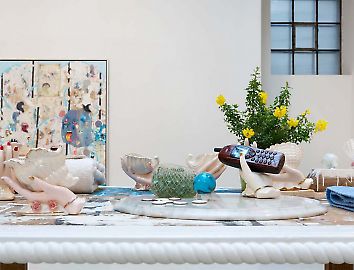Carter -- American Painting
Carter, Vibrations (atmosphere of place), 2016 / 2017, 183 x 142 cm, acrylic paint, paper, thread, fabric, towel, pencil, colored pencil, gel medium on canvas, photo: Matthias Bildstein, courtesy: Carter & Georg Kargl Fine Arts, Vienna
Carter, Facet, 2016 / 2017, 183 x 142 cm, acrylic paint, paper, thread, fabric, towel, gel medium on canvas, photo: Matthias Bildstein, courtesy: Carter & Georg Kargl Fine Arts, Vienna
Carter, Trajectory, 2016 / 2017, 127 x 102 cm, acrylic paint, paper, thread, fabric, towel, pencil, colored pencil, gel medium on canvas, photo: Matthias Bildstein, courtesy: Carter & Georg Kargl Fine Arts, Vienna
Carter, Hovering Empathy, 2016 / 2017, 183 x 142 cm, acrylic paint, paper, thread, fabric, towel, parachute cord, pencil, colored pencil, gel medium on canvas, photo: Matthias Bildstein, courtesy: Carter & Georg Kargl Fine Arts, Vienna
Carter, Amplification, 2016 / 2017, 81 x 56 cm, acrylic paint, paper, thread, fabric, towel, pencil, colored pencil, parachute cord, gel medium on canvas, photo: Matthias Bildstein, courtesy: Georg Kargl Fine Arts, Vienna
“I think one general misconception of my work is that it’s always a form of self-portraiture. It really isn’t. It’s more the idea of portraiture that I’m interested in.“ 1 answers American artist and filmmaker Carter when questioned in an interview about his painting and sculptural work. In his earlier works, Carter used handmade, marbled paper as support background and pasted-on synthetic hair as artificial representation of the corporeal or joined photographs of meticulously decorated, bourgeois interiors from the 1950s and ́60s alongside his signature floating heads, body fragments and brushstrokes, more recently his artistic methods have been essentially changed.
For his third solo exhibition at Georg Kargl Fine Arts, Carter has swapped the brush for a manual sewing machine, has interwoven towels into the picture support and has changed his reduced color range from blue, grey and black to a rich multicolored spectrum. Although paint is still applied to the surface he has introduced an incredibly detailed stitching using brightly colored thread. Nevertheless Carter’s artistic style remains unique, distinctive and individual. It consists of subtle variations of repeating colors, such as pink, red, light blue or neon yellow and green. Shapes of hand-sewn faces, meticulously sewn eyes, wide opened mouths with brightly colored lips and teeth, stuck out tongues and floating heads manically run through his entire new body of work. The facial images live in a space that’s perhaps both absurd and ghastly, yet ultimately detached from any specific feeling or emotion. Tightly applied to the support, Carter’s blending of the foreground with the partly painted background creates a complete visual space in constructing a dense fabric of references out of formal, semantic and historic allusions.
He casually quotes art historical examples and applies their formal achievements. In his current exhibition, entitled American Painting, he refers directly to his artistic predecessors and his own American tradition. Comparable to Robert Rauschenberg having merged painterly and sculptural elements into his Combine Paintings by incorporating found objects, Carter is using coins with head motives, lace doilies and popular yet dated emblems, which can be read in the long American tradition of quilting or hand-stitched Samplers. Andy Warhol with his analyses of identity constructs, role models and sexuality, Hockney or Picasso’s shattering of the figure into both formal and conceptual Cubist bits, or Cindy Sherman and her play with grotesque masks, costumes and suppressed fantasies can be seen as points of departure, even if Carter deals with such issues in a more reserved manner. Casting a wider net and referencing the counter-culture movements of the 1960s and '70s and various cults both sinister and peacefully communal, the artist is influenced by the clothing, codified symbols, art and atmosphere of the time.
Speaking in terms of form, Carter’s methods never result in painting, sculpture, photography or drawing as such. His work is all of them and, at the same time, always in-between. In terms of content, it points out that everything connected to gender, sexual, or social identity is never stable or natural, but appears to be the product of a social and cultural process of construction.
Carter's works are not bound to rigid ascriptions, and they never can be. According to the artist's explicit wish, here is a list of the following Wikipedia links that gives a broader insight in his artistic engagement over the past few years.
American painting:
https://en.wikipedia.org/wiki/Visual_art_of_the_United_States
Portraiture:
https://en.wikipedia.org/wiki/Portrait
Homosexuality (history / trajectory / closet):
https://en.wikipedia.org/wiki/Homosexuality_and_psychology
The Source Family
https://en.wikipedia.org/wiki/Father_Yod
Charles Manson / family:
https://en.wikipedia.org/wiki/Manson_Family
1960’s counter culture:
https://en.wikipedia.org/wiki/Counterculture_of_the_1960s
Cults:
https://en.wikipedia.org/wiki/Cult
1970’s:
https://en.wikipedia.org/wiki/1970s
Towels (the body):
https://en.wikipedia.org/wiki/Towel
Flags:
https://en.wikipedia.org/wiki/Flag
Samplers:
https://en.wikipedia.org/wiki/Sampler_(needlework)
Phillip Guston:
https://en.wikipedia.org/wiki/Philip_Guston
Feelings:
https://en.wikipedia.org/wiki/Feeling
Empathy:
https://en.wikipedia.org/wiki/Empathy
Craft:
https://en.wikipedia.org/wiki/Craft
Hand Model (ceramic sculpture):
https://en.wikipedia.org/wiki/Hand_model
Conceptual Art:
https://en.wikipedia.org/wiki/Conceptual_art
Early American Quakers / Society of Friends / Jemima Wilkinson:
https://en.wikipedia.org/wiki/Jemima_Wilkinson
Hollywood cults:
http://www.refinery29.com/2015/06/97992/famous-hollywood-cults-history
David Hockney:
https://en.wikipedia.org/wiki/David_Hockney
Rolling Stones:
https://en.wikipedia.org/wiki/The_Rolling_Stones
Clothing, patches:
https://www.asildastore.com/blogs/news/103889222-a-brief-fashion-history-the-role-of-clothing-patches-in-counterculture
Carter was born 1970 in Norwich, Connecticut and lives currently in Orient, Long Island, and New York City. He studied at the Maryland Institute College of Art, at the Skowhegan School of Painting and Sculpture and the University of California, Davis. His works have been exhibited internationally, including the Whitney Museum of American Art in New York, Museum of Modern Art, New York, San Francisco Museum of Modern Art, White Columns, New York, Tate Modern, London, The Royal Academy, London, Saatchi Gallery in London, and the Museion in Bolzano, Italy. His works were shown in several galleries such as Yvon Lambert, Paris, Salon 94 Freemans, New York, Marc Jancou, Geneva and 2007, 2011, 2012 at Georg Kargl Fine Arts, Vienna. In 2009/2010 in a collaboration with the America actor, James Franco, Carter wrote and directed Erased James Franco, which has been shown at the Museum of Modern Art, New York, Tate Modern, London, Cleveland Museum of Art, Portland Museum of Art, San Francisco Museum of Modern Art and The Castro Theater, San Francisco. In 2013 he wrote and directed the feature film Maladies, which has been screened at Berlinale, Berlin, at SXSW film festival in Austin, TX and at Copenhagen International Film Festival in Denmark.
A comprehensive catalogue of Carter’s work edited by Georg Kargl was published in 2008 titled, An Arm with Hair, (The Vienna Catalogue 1973) including an interview by Matthew Higgs and an essay by Fiona Liewehr.
Text: Fiona Liewehr
[1] Carter in conversation with Matthew Higgs, in: An Arm with Hair, (The Vienna Catalogue 1973), Wien 2008, p. 21


